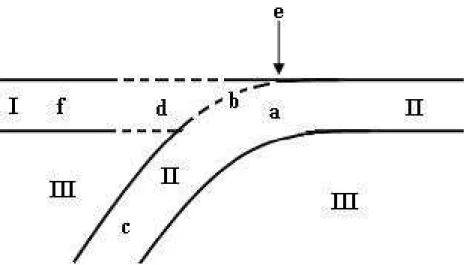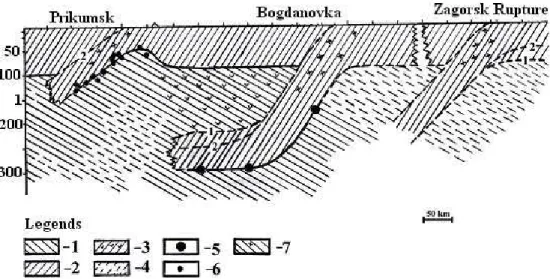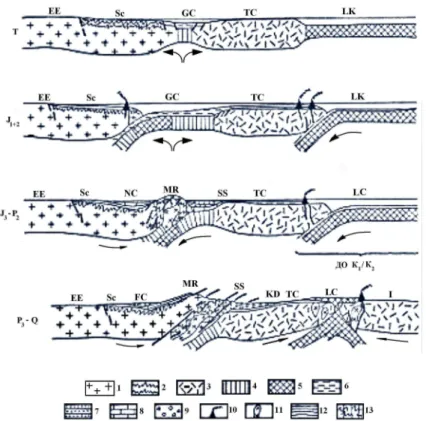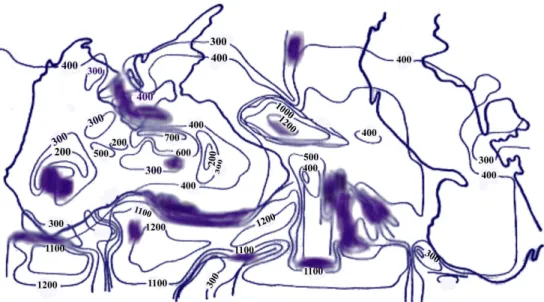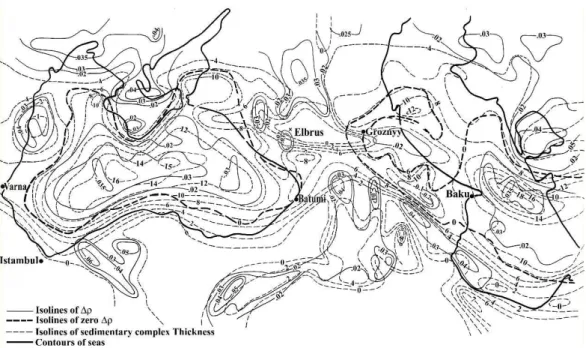eED
4, 77–89, 2009Thermogeodynamic manifestations in the
Caucasus and their genesis
G. E. Gugunava et al.
Title Page
Abstract Introduction
Conclusions References
Tables Figures
◭ ◮
◭ ◮
Back Close
Full Screen / Esc
Printer-friendly Version
Interactive Discussion
eEarth Discuss., 4, 77–89, 2009
www.electronic-earth-discuss.net/4/77/2009/ © Author(s) 2009. This work is distributed under the Creative Commons Attribution 3.0 License.
eEarth Discussions
eEarth Discussionsis the access reviewed discussion forum ofeEarth
Thermogeodynamic manifestations in the
Caucasus and their genesis
G. E. Gugunava1, J. K. Kiria1, and T. B. Bochorishvili1,2
1
Institute of Geophysics, Georgian Academy of Sciences, Rukhadze St 1, 0193 Tbilisi, Georgia
2
Institute of Informatics, University of Podlasie, 3-go Maja 54, 08-110 Siedlce, Poland
Received: 8 March 2009 – Accepted: 26 August 2009 – Published: 29 September 2009
Correspondence to: T. B. Botchorishvili (tengo10@.wp.pl)
eED
4, 77–89, 2009Thermogeodynamic manifestations in the
Caucasus and their genesis
G. E. Gugunava et al.
Title Page
Abstract Introduction
Conclusions References
Tables Figures
◭ ◮
◭ ◮
Back Close
Full Screen / Esc
Printer-friendly Version
Interactive Discussion
Abstract
In the work two aspects of thermal character are considered: first of all this is the con-nection of subduction phenomena with thermal life of the Caucasus on the basis of over interpreted data of magnetotelluric sounding, and secondly, origin of thermostressed condition of the Caucasus and its geological aspects which is manifested in the
follow-5
ing:
1. in the zones of anomalous thermodisplacements thermofaults should occur (Le Pishon et al., 1977). These thermofaults are in good correlation with deep faults which are distinguished by geological and seismic methods, these thermofaults may be earthquake sources (Spitak, Racha, etc. earthquakes), also may be
chan-10
nels through which magma derivates (giving mineral deposits) may penetrate on surface (Gugunava and Gijeishvili, 1989);
2. in the body of sedimentary complex thermostressed seals and seal failures occur, which are apparently traps for oil-gas fluids. Good correlation of thermodense anomalies with oil deposits of the Caucasus is shown (Alexidze et al., 1985;
Gu-15
gunava, 1980).
Everything above mentioned was carried out within frames of stationary thermal model which did not allow us to reveal time characteristics of interconnection of geological medium and thermal field.
Now investigations are being carried out within the frames of stationary thermal
20
model and its interconnection with geological environment.
1 Introduction
eED
4, 77–89, 2009Thermogeodynamic manifestations in the
Caucasus and their genesis
G. E. Gugunava et al.
Title Page
Abstract Introduction
Conclusions References
Tables Figures
◭ ◮
◭ ◮
Back Close
Full Screen / Esc
Printer-friendly Version
Interactive Discussion
mechanisms of these “tectonic” manifestations. At least three classes of earthquakes, which are conditioned by thermal effects, can be distinguished:
a) earthquakes which are conditioned by subduction of cold-heavy part of litho-sphere plate,
b) earthquakes which are connected with vertical thermo-displacements in the crust
5
and the sedimentary complex,
c) earthquakes which are conditioned by thermo dense effects; all of them are con-nected with thermal processes.
Secondly, thermogeodynamic manifestations are expressed in increased heat flows.
2 Problem discussion
10
According to Le Pishon et al. (1977), during subduction considerable energy is released which is conditioned see Fig. 1 by advance of plate II under plate I along zone b.
“Elastic energy, accumulated along contact plane b, should be released in earth-quakes with accompanying advances. One of the results of considered heating up of sinking plate is that the fraction of surrounding rocks with low melting point will melt
15
down and begin upward migration, thus conditioning magmatism and gradual heating up of the whole zone between c and d. Secondary effect occurs: in d zone anoma-lously high heat flow appears” (Le Pishon et al., 1977). Let’s consider each mechanism separately applied to the Caucasus. Thermal anomalies of the Caucasus correspond just to this very model.
20
It is necessary to note that this is not the only mechanism of upward migration of fluids. According to the mechanism offered in Gugunava and Gijeishvili (1989), in some regions, when temperature reaches 600◦C, a layer of partial melt of water saturation granites and basalts occurs, which can also migrate upwards, increasing heat flow on the surface and conditioning low temperature volcanism (Elbrus, Kazbeg, etc.).
eED
4, 77–89, 2009Thermogeodynamic manifestations in the
Caucasus and their genesis
G. E. Gugunava et al.
Title Page
Abstract Introduction
Conclusions References
Tables Figures
◭ ◮
◭ ◮
Back Close
Full Screen / Esc
Printer-friendly Version
Interactive Discussion
Formal consideration of subduction in the Greater Caucasus speaks Figs. 2, 3 about perfect correlation with the scheme (Fig. 1) which was considered in Le Pishon et al. (1977).
These are: subduction zone, which was experimentally marked out by method of Deep Magnitotelluric Sounding (DMTS) (Fig. 2) (Alexidze et al., 1985), seismic
mani-5
festations, and high heat flow in the Greater Caucasus (zone d) according to scheme in Le Pishon et al. (1977).
In connection with this the mechanism of occurring of deflection of the Greater Cau-casus in P1−2 period and its uplifting in I3−P3 and P3−Q is very interesting (Gugu-nava, 1980). It seems that if we consider the whole paleoreconstructional geosyncline
10
scheme (Sikharulidze, 1978) in the aspect of global tectonics, it can be seen as mov-ing in time with the whole plate towards subduction zone and then deflection of the Greater Caucasus area inJ1−2period is nothing more than the result of old subduction with formation of deep-water trough before subduction front, and uplifting inJ3−P2 pe-riod occurs along old subduction surface. And only fromP3−Q period old subduction
15
structure wakes up, as illustrated in Fig. 3 (Sholpo, 1978).
Deep-water depression, which is filled with sediments, is more warmed up than sur-roundings and together with friction warm-up along sinking plate surface (Alexidze et al., 1985) show signs of more warming up during uplifting. It turns out that one and the same phenomena on the surface may be conditioned either by both factors or by each
20
factor separately.
It is very interesting second possible mechanism of earthquakes at the expense of worming up by deep heat of the whole geological structure of the region and occurrence of thermovertical displacements inside it.
On the basis of geological model the stationary model of the Caucasus was
con-25
eED
4, 77–89, 2009Thermogeodynamic manifestations in the
Caucasus and their genesis
G. E. Gugunava et al.
Title Page
Abstract Introduction
Conclusions References
Tables Figures
◭ ◮
◭ ◮
Back Close
Full Screen / Esc
Printer-friendly Version
Interactive Discussion
disposed between them, undergo compression (seal).
While shifting from one geological structure to another various vertical displacements occur which in some cases reach high enough values, 16 m/km order and more, which inevitably result faults. Such faults are revealed in the Caucasus, see Fig. 4 (Sholpo, 1978; Hain, 1984).
5
Figure 4 shows the system of thermo-faults of the Caucasus. Areas of the height-ened risk of origin of deep faults, and therefore of earthquakes, are denoted by shaded sections where vertical displacements exceed 16 m/km. Analogous picture of faults sections the whole sedimentary complex granite and basalt.
Often earthquakes are observed along these faults (Spitaki, Racha earthquakes,
10
etc.).
Third mechanism of earthquakes (besides many others) consists in the process of occurring thermodense anomalies (Alexidze et al., 1993; Gugunava et al., 2006), which in some cases are connected with seismomanifestations, as well as oil-gas presence (Gugunava, 1994).
15
Figure 5 gives the system of thermodense anomalies. Formation of thermodense anomalies may be accompanied by local demolition of “old” structures, thus condition-ing seismicity of the given region.
The question about the mechanism of increased heat flow in subduction zone arises. While considering processes at destructive boundaries of plates Hasebe et al. (1970)
20
note that to explain high heat flow it is not enough to evaluate heat effect which is conditioned by adiabatic compression and phase transition, i.e. changes of olivine-shnilel transition.
In Hain (1984) a conclusion is drawn that “it is impossible to explain the existence of magmatism, which is connected with sinking plate, if heat source on plate surface
25
or inside plate is not assumed”. In order to settle this contradiction McKensie (1970) supposed that increased heat flow zone is conditioned by secondary convection which occurs while plate is sinking, resulting in warming up during friction at small depths.
eED
4, 77–89, 2009Thermogeodynamic manifestations in the
Caucasus and their genesis
G. E. Gugunava et al.
Title Page
Abstract Introduction
Conclusions References
Tables Figures
◭ ◮
◭ ◮
Back Close
Full Screen / Esc
Printer-friendly Version
Interactive Discussion
necessary, and energy lack can be met on the basis of the offered in Alexsidze (1991) and Gugunava (1995) mechanism.
Conducted in Alexsidze (1991) and Gugunava (1995) calculations of the thermal field of the Caucasus for different depths (up to lower boundary of the upper mantle), and especially of the Greater Caucasus, show that in this region 600◦C isotherm is lifted 5
clear of the surface of Moho. This means, that in conditions of rehydrated granites and basalts, their partial melting takes place, which existed long before origin of subduction situation (Fig. 4) and lithosphere plate passes through half-melt. From here is the source of heat and melted magma, which penetrates in upper horizons by cracks in the area of thermoelastic vertical and horizontal displacements, as can be seen from
10
Fig. 4 (Le Pishon et al., 1977), which form the system of deep faults. It may be that this mechanism will be acceptable for some other regions.
3 Conclusions
Basic possible mechanisms of thermogeodynamic manifestations are considered.
1. Thermal nature of subductional occurrences (sinking of cold heavy part of
litho-15
sphere plate) and earthquakes which are connected with them.
2. Excessive heat flow, conditioned by emersion of low-temperature fraction within the Caucasus and before subduction front at the expense of friction heat and partial melt of rocks of water-contained granite and basalt in the area of 600◦C deep temperatures.
20
3. Origin of vertical thermodisplacements, conditioned by deep heat, and earth-quakes which are connected with them.
eED
4, 77–89, 2009Thermogeodynamic manifestations in the
Caucasus and their genesis
G. E. Gugunava et al.
Title Page
Abstract Introduction
Conclusions References
Tables Figures
◭ ◮
◭ ◮
Back Close
Full Screen / Esc
Printer-friendly Version
Interactive Discussion
5. The mechanisms of increased heat flow in subduction zone of the Caucasus is offered.
References
Alexidze M. A., Gugunava, G. E., Kiria, J. K., and Chelidze, T. L.: Thermal model, crustal inversional layer and young volcanism of the Caucasus, Bulletin of the Georgian Academy 5
of Sciences, 113, 517–521, 1985.
Alexidze, M. A., Gugunava, G. E., Kiknadze, D. A., Kiria, J. K., and Chelidze, T. L.: Geother-mal model of the Caucasus and crustal astenosphere, in: Proceedings of the International Conference on Gepthermal Model of Geological Structures and Crustal Astenosphere, St-Peterburg, Russia, 91–96, September 1991.
10
Alexidze, M. A., Gugunava, G. E., Kiria, J. K., and Chelidze, T. L.: A three-dimensional geother-mal stationary model of thergeother-mal and thermoelastic fields of Caucasus Erratum, Tectono-physics, 227, 191–203, 1993.
Gugunava, G. E.: On construction of geoelectric model of the upper mantle of the Caucasus, Bulletin of the Georgian Academy of Sciences, 100, 89–92, 1980.
15
Gugunava G. E. and Gijeishvili S. O.: About possible thermoelastic nature of Spitak earthquake, Thesis in: regional conf. Sverdlovsk, Russia, 44 pp., 1989.
Gugunava, G. E.: On thermoelastic mechanism of oil-gas migration, Bulletin of the Georgian Academy of Sciences, 150, 58–63, 1994.
Gugunava, G. E.: On thermoelastic mechanisms of genesis of oil fields region and method of 20
their reveal, Journal of Georgian Geophysics Society Issue (A), Physics of solid earth, 1, 116–119, 1995.
Gugunava, G. E., Kiria, J. K., Gogiashvili, J. V., and Kiknadze, D. A.: On genesis of Shamkori, Spitak and Racha-Java earthquakes, Journal of the Georgian Geophysical Society Issue (A), 11, 63–68, 2006.
25
Hain, V. N.: Regional geotectonics (Alpine Mediterranean Belt), Nedra, Moscow, 181–188, 1984.
eED
4, 77–89, 2009Thermogeodynamic manifestations in the
Caucasus and their genesis
G. E. Gugunava et al.
Title Page
Abstract Introduction
Conclusions References
Tables Figures
◭ ◮
◭ ◮
Back Close
Full Screen / Esc
Printer-friendly Version
Interactive Discussion
Le Pishon, K., Franshto, J., and Bonnin, J.: Plate tectonics, edited by: Karasik, A. M., Hain, V. N., MIR, Moscow, 201–204, 1977.
McKensie, P.: Temperature and potential temperature beneath island arcs, Tectonophysics, 10, 357–366, 1970.
Sholpo V. N.: Alpine geodynamics of the Greater Caucasus, Nedra, Moscow, 1978. 5
eED
4, 77–89, 2009Thermogeodynamic manifestations in the
Caucasus and their genesis
G. E. Gugunava et al.
Title Page
Abstract Introduction
Conclusions References
Tables Figures
◭ ◮
◭ ◮
Back Close
Full Screen / Esc
Printer-friendly Version
Interactive Discussion
eED
4, 77–89, 2009Thermogeodynamic manifestations in the
Caucasus and their genesis
G. E. Gugunava et al.
Title Page
Abstract Introduction
Conclusions References
Tables Figures
◭ ◮
◭ ◮
Back Close
Full Screen / Esc
Printer-friendly Version
Interactive Discussion
eED
4, 77–89, 2009Thermogeodynamic manifestations in the
Caucasus and their genesis
G. E. Gugunava et al.
Title Page
Abstract Introduction
Conclusions References
Tables Figures
◭ ◮
◭ ◮
Back Close
Full Screen / Esc
Printer-friendly Version
Interactive Discussion
eED
4, 77–89, 2009Thermogeodynamic manifestations in the
Caucasus and their genesis
G. E. Gugunava et al.
Title Page
Abstract Introduction
Conclusions References
Tables Figures
◭ ◮
◭ ◮
Back Close
Full Screen / Esc
Printer-friendly Version
Interactive Discussion
eED
4, 77–89, 2009Thermogeodynamic manifestations in the
Caucasus and their genesis
G. E. Gugunava et al.
Title Page
Abstract Introduction
Conclusions References
Tables Figures
◭ ◮
◭ ◮
Back Close
Full Screen / Esc
Printer-friendly Version
Interactive Discussion
